The diminutive size of the British bathroom has been well-documented in newbuild houses, from the reduction of floorspace in new build homes (which are the smallest in Western Europe) through to the expectation of more bathing facilities in a dwelling.
However, smaller bathrooms are also key for refurbishment sales. Multiple bathrooms offer convenience for the multigenerational household, which has seen an increase in numbers of 38% from 2009 to 2014, according to the National House Building Council.
They can add value to a home of around 6% or £13,000 of an average-sized dwelling, Virgin Money reports. So a win-win for homeowners!
Sponsored Video
Little but luxurious
There may be a restriction on size, but it doesn’t mean there has to be a compromise on the design aesthetics of the project.
Marketing director of Victora + Albert Baths Jonathan Carter comments: “There are now more compact products available that look great and also work in small spaces. It’s not only large bathrooms that can be luxurious.”
These span space-saving baths and showering surrounds, through to slimline sanitary-ware and furniture, as well as reduced scale brassware, such as miniature mixers and concealed showers.
National sales and marketing manager for Mereway Bathrooms Tony McNeally advises designers to look at a wide portfolio of products when specifying for smaller bathroom projects:
“Don’t forget to utilise all options, narrow furniture, corner units and short projection WC pans can create much more leg room when all used together.”
Bath versus shower
Starting with one of the most contentious issues, whether a shower is the natural replacement for a bath, in a smaller area, seemingly the answer is no.
Baths have now been developed so they can fit small spaces or even use previously redundant areas.
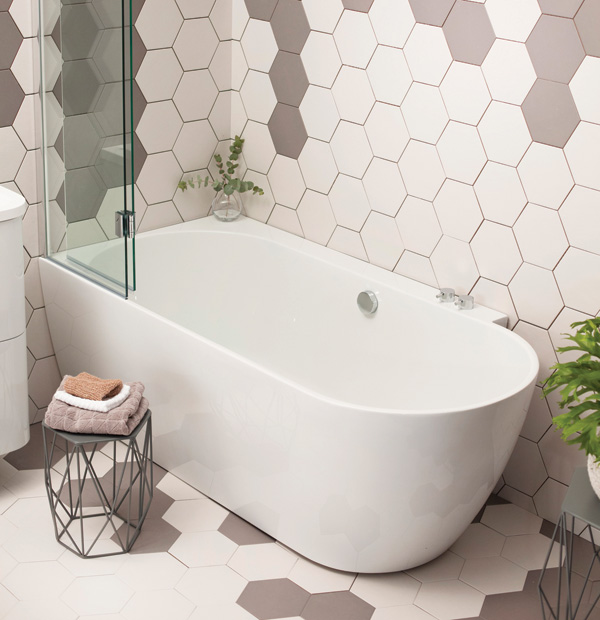
The Ebb Hybrid Shower Bath combines the look of an open-ended, freestanding bath but has also been designed for an over-bath shower installation. It measures 1660mm in length and 800mm in width- Waters Baths of Ashbourne
Head of marketing at Bette Sven Resinghoff explains:
“We have over 20 baths specifically designed for small spaces, including those that have part of the bath surround cut away on the angle, so they can be used where door openings would normally prevent the use of a bath with good lying area.”
Jonathan Carter says Victoria + Albert has also introduced a number of smaller models into its range over the last couple of years:
“The compact Vetralia is our smallest bath and is quickly becoming one of the most popular”. He adds: “We’re certainly focussing on developing more compact solutions for bathrooms; it’s no coincidence that all the recently introduced models are around 1700mm in length.”
Inward looking
The shower enclosure has to counter the added complication of height in a small or restrictive space, where sloping walls and low ceilings may be problematic.
Barry Hoyne of Merlyn Showering states: “Advanced cutting techniques and greater choice of shower enclosures opens up a lot more possibilities.”
Managing director of Aqata Jayne Barnes agrees, commenting: “Enclosures can be created for special heights and widths or with angled panels, doors and screens to fit a sloping ceiling.”
To counter the added difficulty of space for a shower surround door opening, the walk-in may appear to be the natural choice as it also offers a like-for-like replacement with a tub.
However, managing director of Roman David Osborne comments: “We have always found our bi-fold door enclosures to be the most popular space-saving products. The advantage of the bi-fold is that it is an inward opening door, so doesn’t project out on to any furniture or fittings.”
He adds: “Our fastest growing space-saving product is our Lumin8 in-swing door.”
In fact, such is the significant of the inward opening door, Merlyn Showering has recently expanded its portfolio, as Barry Hoyne continues: “Our newly launched Arysto Infold Door is a great option for smaller bathrooms.”
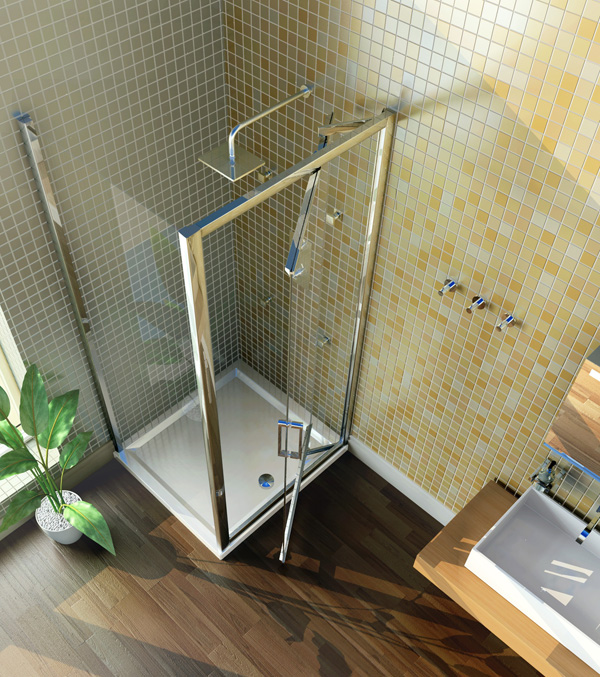
Part of the 8 Series is this infold door shower enclosure, which as its name suggests is made from 8mm glass and has an inward opening mechanism. It measures 760mm and can be used for a corner installation
Barely there brassware
While focus may naturally fall on the largest elements of the bathroom, the smallest items of brassware also play an important role in the design of small bathrooms.
Reduced scale sanitary-ware requires proportional taps and to maximise space in a shower enclosure, industry experts advise designers to consider concealed models explain experts.
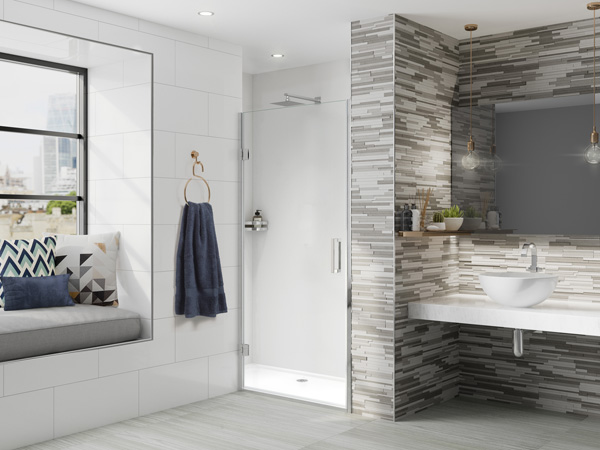
The Design Solution DS455 from Aqata starts from 760mm and can be used for small recess areas. It is made from 10mm glass, features frameless glass and can be ordered with minimal fixing
Head of marketing at Methven UK Simon Cornelius comments: “There has been a significant increase in the number of smaller, more versatile taps designed specifically for compact bathrooms being released in recent years”.
“These mini mixers typically feature directional aerators which streamline the water flow and minimise splash back, making them perfectly suited for smaller basins.”
And he continues: “the bathroom industry continues to see an increase in sales of concealed shower valves too, as they require less space, particularly in smaller shower enclosures.”
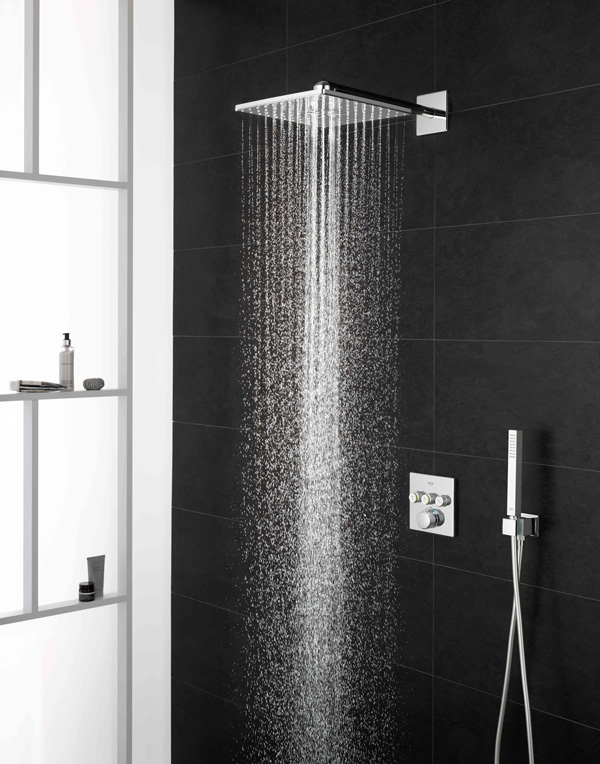
Helping create space in a small enclosure are concealed shower valves such as the SmartControl, with a wall plate which protrudes 10mm from the wall. Available in square and round formats, and in a choice of chrome or moon white acrylic glass, it features push and turn controls- Grohe
His view is re-iterated by senior product manager for Grohe UK Paul Bailey who says: “Space saving, concealed products are ideal for compact bathroom design because the mechanics of the product are behind the wall”.
“Products such as concealed shower valves and toilet installations enable homeowners with limited space to achieve a high spec bathroom that emulates hotel chic and luxury designs.”
High ideals
It neatly brings us on to sanitary-ware, and while the benefits of back-to-wall and short projection WCs and complementary slim-line basins may be long recognised in planning small bathrooms, perhaps less obvious is the impact of classical design on tiny spaces.
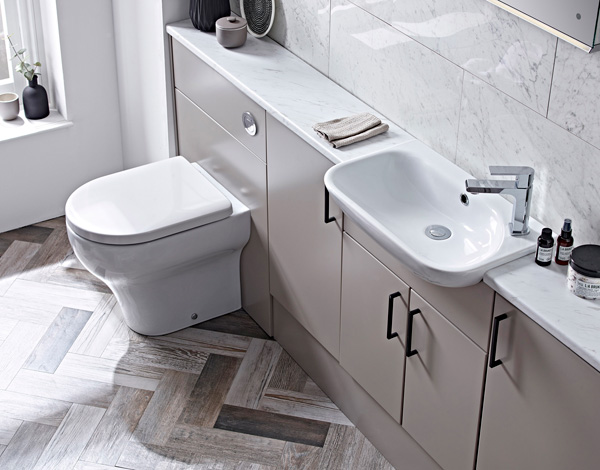
Note sanitary-ware has been extended with a slim-depth, semi-countertop basin designed for use with fitted furniture with a maximum depth of 215mm. It is shown with the Note back-to-wall WC – Roper Rhodes
“High level cisterns are ideal for the small bathroom”, says managing director of Thomas Crapper Paul Dwyer.
He explains: “By their very nature, they create the illusion of height which can be useful especially in rooms where space is at a premium.”
While Frontline Bathrooms has looked to classical design for its space-saving Holborn basin, which incorporates a heated towel rail.

Incorporating a basin and heated towel rail as a washstand, Holborn measures 500mm wide. The two tap hole basin sits on top of the rail which offers 525 Btu and with pipe centres of 318mm – Frontline Bathrooms
Designers are not also being encouraged to think about the sanitary-ware design but also its positioning, as head of marketing and product development at Saniflo,UK Ann Boardman comments:
“I would say don’t be restricted by drainage. Let’s say you want to create a small bathroom in a bedroom; you can use a Saniflo unit to pump the waste vertically into the roof void above and horizontally across the loft to then drop down to the ground floor and enter the ‘s’ trap discharge spigot at the back of the existing WC.”

The Sanislim macerator from Saniflow allows designers to create bathroom facilities even when the room doesn’t have large bore pipework, as it has inlets either side for a shower and basin. Measuring 145mm deep, it can pump waste water through 22mm bore pipework up to 4m vertically or 40m horizontally (or a lesser combination of both)
Fitting in furniture
To conceal the plumbing and to create a clutter-free look is essential whatever sized project, but particularly the bathroom. Here is where storage comes into its own.
It hasn’t always been the case as Wayne Dance, managing director of InHouse which sells Pelpal explains:
“The market for bathroom furniture for small spaces has always been there but with manufacturers too often focussed on the perceived big bucks associated with larger scale designs, they have paid scant attention to small scale furniture. With the smaller space representing a large share of the UK market, it’s been a glaring oversight.”
And he continues, explaining designers should look at the brand they are working with: “Forget about compromising, if you pick the right brand you don’t need to. The best furniture doesn’t bust the budget, it works within it.”
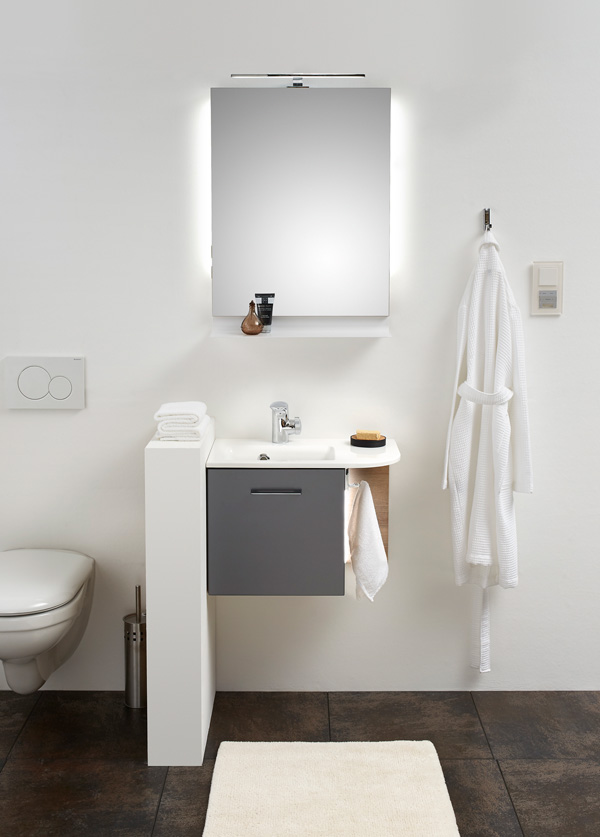
The Solitaire 9015 from Pelipal has washbasins and cabinet ends in learner curved designs, alongside central, left or right-handed options. It allows designers to combine cabinets, washbasins, drawers, fronts and shelving
Now there is a choice of slimline designs and manufacturers have looked to inspired use of wall space.
Marketing director of Utopia Bathrooms Beth Boulton comments: “We have increased our fitted furniture offering with a great range of reduced depth options”, continuing: “We have developed more creative storage solutions including tall wall options, washbasin units and mirror cabinets”.
Boulton advises: “Use the space above the toilet to add cupboards or shelving.”
Certainly there are more ideas than ever before for the smaller bathroom.
With these space-saving concepts flagged up in manufacturers’ brochures and small bathrooms replicated in high street showrooms, designers should be able to meet the needs of clients with the most restrictive of spaces.
Finally, small talk can not only be advantageous but also highly profitable.



